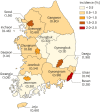Pulmonary Surfactant Replacement Therapy for Respiratory Distress Syndrome in Neonates: a Nationwide Epidemiological Study in Korea
- PMID: 32808509
- PMCID: PMC7431283
- DOI: 10.3346/jkms.2020.35.e253
Pulmonary Surfactant Replacement Therapy for Respiratory Distress Syndrome in Neonates: a Nationwide Epidemiological Study in Korea
Abstract
Background: Pulmonary surfactant (PS) replacement therapy, as a safe and effective treatment for respiratory distress syndrome (RDS) may have further increased with the extended insurance coverage since 2011 in Korea. Thus, this study aimed to investigate the epidemiologic data of PS replacement therapy for RDS in Korea and to analyze the complications associated with RDS.
Methods: We included 19,442 infants who were treated with PS and diagnosed with RDS (International Classification of Diseases-10 codes: P22.0) between 2014 and 2018 from the Health Insurance Review and Assessment database. Birth certificate data from Statistics Korea were used to estimate the incidence of RDS.
Results: The average incidence of RDS within the study period was 0.99% among live births. Repeated doses of PS were administered to 1,688 infants (8.7%), ranging from 2 doses in 929 infants (4.8%) to 9 doses in 1 infant (0.01%). The incidence of RDS in term infants markedly increased over 5 years from 0.2% to 0.34%. The incidence was similarly increased among the preterm infants. The RDS mortality rate was 6.3% and showed a decreasing trend according to year. The mortality rate was significantly higher in the lower gestational age group. A decreasing trend was observed in the incidence of the complications, such as patent ductus arteriosus, intraventricular hemorrhage, and bronchopulmonary dysplasia, except for pneumothorax in term infants. The complications were also higher in the lower gestational age group and the lower birth weight group. However, pneumothorax was the most frequent complication in the term infant group and in infants with birth weight ≥ 2,500 g.
Conclusion: Advancements in neonatal care and extended insurance coverage have increased the use of PS replacement therapy for RDS. This, in turn, decreased neonatal mortality and the incidence of the associated complications. The appropriate therapeutic strategy for RDS should be decided according to the gestational age and lung pathology.
Keywords: Epidemiologic Studies; Infants, Newborn; Pulmonary Surfactant; Respiratory Distress Syndrome.
© 2020 The Korean Academy of Medical Sciences.
Conflict of interest statement
The authors have no potential conflicts of interest to disclose.
Figures
Similar articles
-
[Epidemiological survey of neonatal respiratory distress syndrome in part of northwest regions in China].Zhonghua Er Ke Za Zhi. 2015 May;53(5):341-7. Zhonghua Er Ke Za Zhi. 2015. PMID: 26080663 Chinese.
-
A multicenter randomized masked comparison trial of synthetic surfactant versus calf lung surfactant extract in the prevention of neonatal respiratory distress syndrome.Pediatrics. 1997 Jul;100(1):39-50. doi: 10.1542/peds.100.1.39. Pediatrics. 1997. PMID: 9200358 Clinical Trial.
-
[The clinical comparative study of preterm respiratory distress syndrome and transient tachypnea of newborn].Zhonghua Er Ke Za Zhi. 2015 Feb;53(2):104-8. Zhonghua Er Ke Za Zhi. 2015. PMID: 25876684 Chinese.
-
History of Pulmonary Surfactant Replacement Therapy for Neonatal Respiratory Distress Syndrome in Korea.J Korean Med Sci. 2019 Jul 1;34(25):e175. doi: 10.3346/jkms.2019.34.e175. J Korean Med Sci. 2019. PMID: 31243934 Free PMC article. Review.
-
Surfactant therapy for neonatal respiratory distress syndrome: a review of Korean experiences over 17 years.J Korean Med Sci. 2009 Dec;24(6):1110-8. doi: 10.3346/jkms.2009.24.6.1110. Epub 2009 Nov 9. J Korean Med Sci. 2009. PMID: 19949668 Free PMC article. Review.
Cited by
-
Comparison of the efficacy of two natural surfactants (BERAKSURF and BLES) in the treatment of respiratory distress syndrome among preterm neonates.BMC Pediatr. 2023 Dec 1;23(1):608. doi: 10.1186/s12887-023-04406-2. BMC Pediatr. 2023. PMID: 38036980 Free PMC article. Clinical Trial.
-
Association of delayed initiation of non-invasive respiratory support with pulmonary air leakage in outborn late-preterm and term neonates.Eur J Pediatr. 2022 Apr;181(4):1651-1660. doi: 10.1007/s00431-021-04317-3. Epub 2022 Jan 10. Eur J Pediatr. 2022. PMID: 35006375
-
Management Practices During Perinatal Respiratory Transition of Very Premature Infants.Front Pediatr. 2022 May 10;10:862038. doi: 10.3389/fped.2022.862038. eCollection 2022. Front Pediatr. 2022. PMID: 35620146 Free PMC article. Review.
-
Tools for assessing lung fluid in neonates with respiratory distress.BMC Pediatr. 2022 Jun 20;22(1):354. doi: 10.1186/s12887-022-03361-8. BMC Pediatr. 2022. PMID: 35725416 Free PMC article.
-
Predicting the need for intubation within 3 h in the neonatal intensive care unit using a multimodal deep neural network.Sci Rep. 2023 Apr 17;13(1):6213. doi: 10.1038/s41598-023-33353-2. Sci Rep. 2023. PMID: 37069174 Free PMC article.
References
-
- Engle WA American Academy of Pediatrics Committee on Fetus and Newborn. Surfactant-replacement therapy for respiratory distress in the preterm and term neonate. Pediatrics. 2008;121(2):419–432. - PubMed
-
- Polin RA, Carlo WA Committee on Fetus and Newborn; American Academy of Pediatrics. Surfactant replacement therapy for preterm and term neonates with respiratory distress. Pediatrics. 2014;133(1):156–163. - PubMed
-
- Soll R, Ozek E. Multiple versus single doses of exogenous surfactant for the prevention or treatment of neonatal respiratory distress syndrome. Cochrane Database Syst Rev. 2009;(1):CD000141. - PubMed
-
- Moya F, Sinha S, D'Agostino RB., Sr Surfactant-replacement therapy for respiratory distress syndrome in the preterm and term neonate: congratulations and corrections. Pediatrics. 2008;121(6):1290–1291. - PubMed
MeSH terms
Substances
Grants and funding
LinkOut - more resources
Full Text Sources


